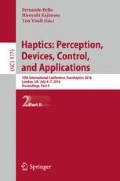Abstract
Wearable haptic technology has been shown to be effective for motion training and rehabilitation. However, one challenge is providing multiple intuitive tactile feedback during walking and hence new feedback methods need to be explored. Experiments were conducted to explore the use of tactile apparent movement on the lower extremity and its feasibility as a feedback modality. Optimal stimulus duration and inter-stimulus onset interval (ISOI) combinations were determined. We obtained the optimal mean ISOIs at six different stimulus durations (from 100–200 ms) and then measured the subjects’ left and right perception accuracy and response times when those stimuli were presented in a randomized trial during standing and walking. This study shows that apparent movement can be an effective feedback modality during walking achieving accuracies of ~100 % and low response times of <1010 ms, given the optimal stimulus.
Access this chapter
Tax calculation will be finalised at checkout
Purchases are for personal use only
References
Kapur, P., Jensen, M., Buxbaum, L.J., Jax, S., Kuchenbecker, K.J.: Spatially distributed tactile feedback for kinesthetic motion guidance, pp. 519–526 (2010)
Bark, K., Wheeler, J.W., Premakumar, S., Cutkosky, M.R.: Comparison of skin stretch and vibrotactile stimulation for feedback of proprioceptive information, pp. 71–78 (2008)
Dachille IX, F., Qin, H., Kaufman, A.: A novel haptics-based interface and sculpting system for physics-based geometric design. Comput. Aided Des. 33, 403–420 (2001)
Fregly, B.J., Reinbolt, J.A., Rooney, K.L., Mitchell, K.H., Chmielewski, T.L.: Design of patient-specific gait modifications for knee osteoarthritis rehabilitation. IEEE Trans. Biomed. Eng. 54, 1687–1695 (2007). doi:10.1109/TBME.2007.891934
Chen, D., Anderson, I., Walker, C., Besier, T.: Lower extremity lateral skin stretch perception for haptic feedback. IEEE Trans. Haptics 9(1), 62–68 (2016)
Lurie, K.L., Shull, P.B., Nesbitt, K.F., Cutkosky, M.R.: Informing haptic feedback design for gait retraining. In: 2011 IEEE World Haptics Conference (WHC), pp. 19–24 (2011)
Sherrick, C.E., Rogers, R.: Apparent haptic movement. Percept. Psychophysics 1, 175–180 (1966)
Burtt, H.E.: Tactual illusions of movement. J. Exp. Psychol. 2, 371 (1917)
Kirman, J.H.: Tactile apparent movement: the effects of interstimulus onset interval and stimulus duration. Percept. Psychophysics 15, 1–6 (1974)
Kirman, J.H.: Tactile apparent movement: the effects of number of stimulators. J. Exp. Psychol. 103, 1175 (1974)
Murata, A., Kemori, S., Moriwaka, M., Hayami, T.: Proposal of automotive 8-directional warning system that makes use of tactile apparent movement. In: Duffy, V.G. (ed.) HCII 2013 and DHM 2013, Part I. LNCS, vol. 8025, pp. 98–107. Springer, Heidelberg (2013)
Israr, A., Poupyrev, I.: Tactile brush: drawing on skin with a tactile grid display, pp. 2019–2028 (2011)
Huisman, G., Darriba Frederiks, A., Van Dijk, B., Hevlen, D., Krose, B.: The TaSST: tactile sleeve for social touch, pp. 211–216 (2013)
Ueda, S., Uchida, M., Nozawa, A., Ide, H.: A tactile display used phantom sensation with apparent movement together. IEEJ Trans. Fundam. Mater. 127, 277–284 (2007)
Van Erp, J.B., Van Veen, H.: A multi-purpose tactile vest for astronauts in the international space station, pp. 405–408 (2003)
Craig, J.C.: Tactile pattern perception and its perturbations. J. Acoust. Soc. Am. 77, 238–246 (1985)
Author information
Authors and Affiliations
Corresponding author
Editor information
Editors and Affiliations
Rights and permissions
Copyright information
© 2016 Springer International Publishing Switzerland
About this paper
Cite this paper
Chen, D.K.Y., Xu, J., Shull, P.B., Besier, T.F. (2016). Tactile Apparent Movement as a Modality for Lower Limb Haptic Feedback. In: Bello, F., Kajimoto, H., Visell, Y. (eds) Haptics: Perception, Devices, Control, and Applications. EuroHaptics 2016. Lecture Notes in Computer Science(), vol 9775. Springer, Cham. https://doi.org/10.1007/978-3-319-42324-1_37
Download citation
DOI: https://doi.org/10.1007/978-3-319-42324-1_37
Published:
Publisher Name: Springer, Cham
Print ISBN: 978-3-319-42323-4
Online ISBN: 978-3-319-42324-1
eBook Packages: Computer ScienceComputer Science (R0)

